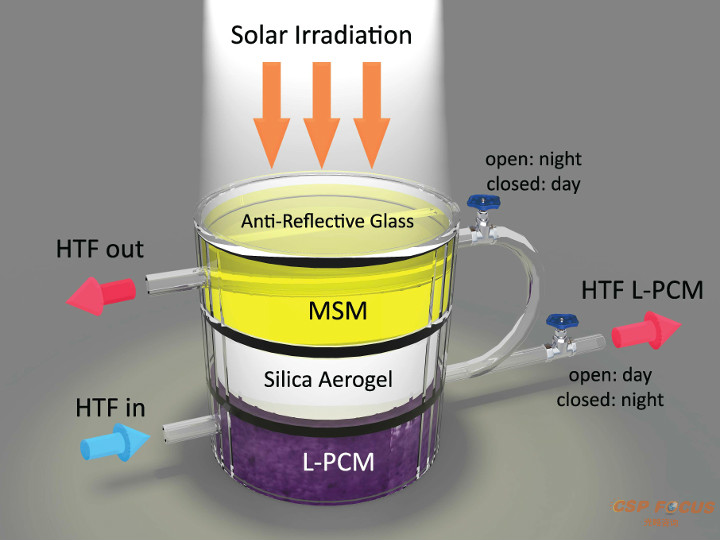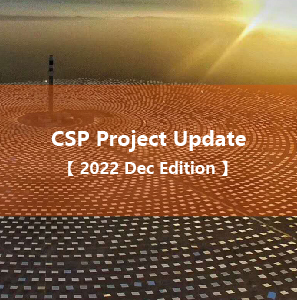Home > Market > Other Regions > Here
Hybrid Solar-Energy–Harvesting Device Enables Uninterrupted Power
2020.01.03 From: helioscsp
Integrated system simultaneously harvests and stores concentrated solar power with low losses for 24/7 power under all conditions.
Researchers at the University of Houston have designed a device that efficiently captures solar energy and stores it for use by applications for the internet of things (IoT) and industrial IoT. Unlike solar panels and solar cells, which use photovoltaic technology for direct electricity generation, the hybrid device leverages the physics of molecular energy and the accumulation of latent heat to make the collection and storage of energy a 24/7 process, addressing a primary shortcoming of current solar products.

Diagram of the new system (Source: “Full Spectrum Solar Thermal Energy Harvesting and Storage by a Molecular and Phase-Change Hybrid Material,” Joule, Vol. 3, Issue 12)
The researchers synthesized the device using norbornadiene-quadricyclane (NBD–QC), an organic compound with high specific energy and extended storage times, as the molecular storage material (MSM), separated from a localized phase-change material (L-PCM) by a silica aerogel to maintain the necessary difference in working temperature.
The common approach for storing solar energy is the use of batteries coupled with photovoltaic systems for both small- and large-scale installations. It is not only electricity that needs to be stored: An equally useful aspect of energy transition is the ability to capture and store solar thermal energy. That goal is not so easy to achieve, however, especially if you need a system that can preserve heat for long periods.
The challenge has spurred a new line of research in recent years that is devoted to the creation of solar storage on demand. The critical point of these systems remains efficiency. The Houston researchers’ development could thus drive decisive change in the thermal-battery sector.
Efficient harvesting and storage of solar thermal energy are essential to exploiting the abundant solar radiation that reaches Earth’s surface. Today’s systems use expensive materials with a high optical concentration, which leads to high heat losses.
The new device is based on a hybrid paradigm that uses daytime heat localization to provide 73% collection efficiency on a small scale and ∼90% on a large scale. In particular, at night, the energy stored by the hybrid system is recovered with 80% efficiency and at a higher temperature than during the day, setting it apart from other state-of-the-art systems, according to a paper published by the researchers in the December issue of Joule.
Classic silicon photovoltaic systems are considered a mature technology that is approaching its theoretical performance limits, though incremental improvements are still being made. At the moment, there is interest in double-sided panels, which take energy not only from the sun but also indirectly from the albedo — the light reflected by rocks, asphalt, or other surfaces.

Chemical structure of the University of Houston researchers’ hybrid system (Source: “Full Spectrum Solar Thermal Energy Harvesting and Storage by a Molecular and Phase-Change Hybrid Material,” Joule, Vol. 3, Issue 12)
A lingering disadvantage of renewable sources such as solar- and wind-based power, however, is their intermittency, which requires the use of batteries to store the generated electricity safely and economically so that it is available for use when needed. The University of Houston researchers say their approach could remove a roadblock to the large-scale adoption of solar energy by enabling 24/7 use of solar power in all seasons and under all weather conditions.
“The high-efficiency harvest is due, in part, to the ability of the device to capture the full spectrum of sunlight, harvesting it for immediate use and converting the excess into molecular energy storage,” said Hadi Ghasemi, Bill D. Cook Associate Professor of Mechanical Engineering at the university and a corresponding author of the paper.
The integrated system also reduces thermal losses because there is no need to transport stored energy through long pipelines.
Technologies to store solar energy at low cost and high efficiency are a critical focus in light of the other developments that are coming to the fore to enable energy security and cope with climate change.
Artificial intelligence, for example, can regulate and optimize flows in smart-grid applications to compensate for solar- and wind-power intermittency and minimize the need to compensate for grid imbalances with thermoelectric power plants.
Upcoming CSP events:
10th CSP Focus China 2020 (March.25-26, Beijing China)
5th CSP Focus MENA 2020(June.23-24,Dubai, UAE)
More CSP news and reports please visit www.cspfocus.cn
or CSP Focus social media on LinkedIn, Twitter, Facebook.
More from CSP Focus
NextEPC tender announced for China CPECC Hami 50MW MS Tower CSP project
Opinion- The Advantages to Develop CSP with Storage in China
Concentrated Solar Power is the way forward for Australia despite hiccups
Sandstone CSP to offer storage below $90/MWh to California utilities
Drone-based solar field inspection service QFly continues market penetration
Rebirth of SolarReserve’s 450 MW Likana Brings CSP Supply Chain Hope for Chile
Leave your thoughts here
Reports(Member Only)
See more+-
CSP Focus Membership Proposals
We are now proposing CSP Focus Membership, hoping to better serve our members to keep pace with the latest updates of ongoing CSP projects worldwide, and to establish and maintain business relations with major shareholders of the projects. CSP Focus offers to Membership exclusive access to:1. Daily/Weekly update and analysis on CSP policies, projects, technologies, market trend and corporate relea
-
The Latest CSP Focus Monthly Update
Join CSP Focus Membership to Get the Latest CSP Focus Monthly Update December Edition.
-
CSP Project Monthly Update 2022 December Edition
CSP Focus is presenting CSP Project (China) Update 2022 December Edition.Detail report is available for CSP Focus Membership.
-
Presentations-CSP Focus China 2021
The Report is for CSP Focus Members only.
Upcoming Events
See more+-
12th CSP Focus China 2022
2022.04.21-22 Beijing
-
11th CSP Focus China 2021
2021.10.28-29 Beijing
-
10th CSP Focus China 2020
2020.10.22-23 Beijing, China
Project Updates
See more+-
Lanzhou Dacheng Dunhuang CSP Project
Asia Pacific-China,Operational,Parabolic Trough
-
Luneng Haixi 50MW Molten Salt Tower CSP Project
Asia Pacific-China,Operational,Power Tower
-
Dubai 950MW NOOR Energy 1 CSP+PV Project
MENA-UAE,Under construction,Power Tower
-
Power China Gonghe 50MW Molten Salt Tower CSP Project
Asia Pacific-China,Operational,Power Tower





